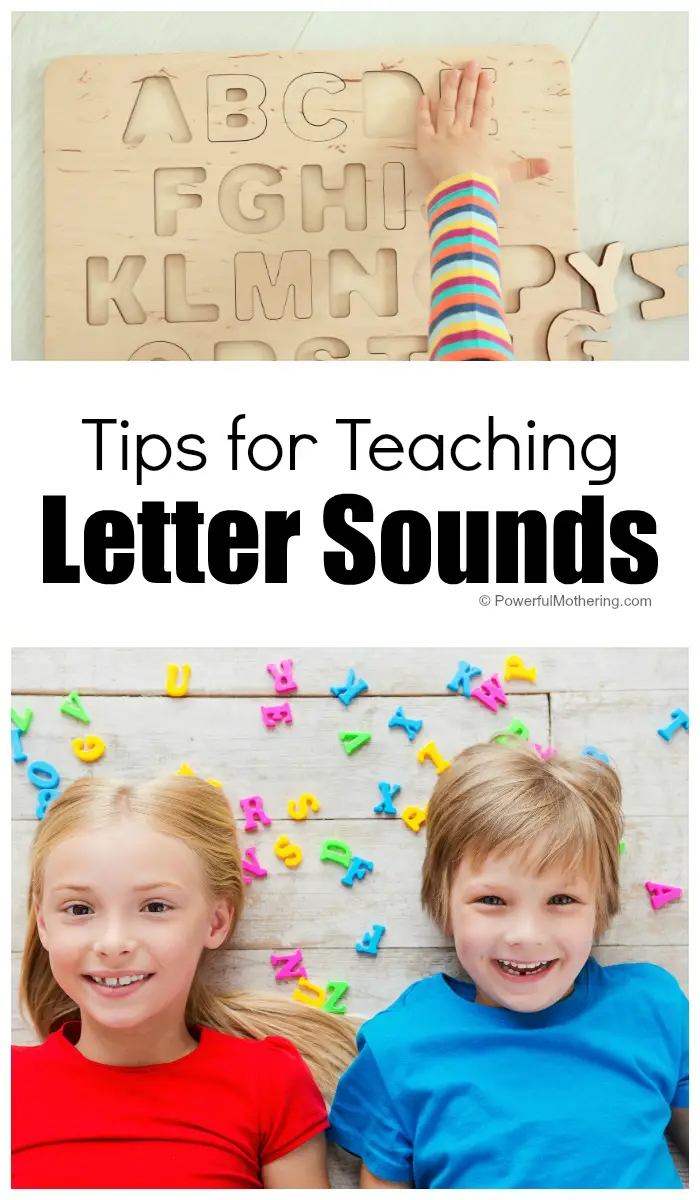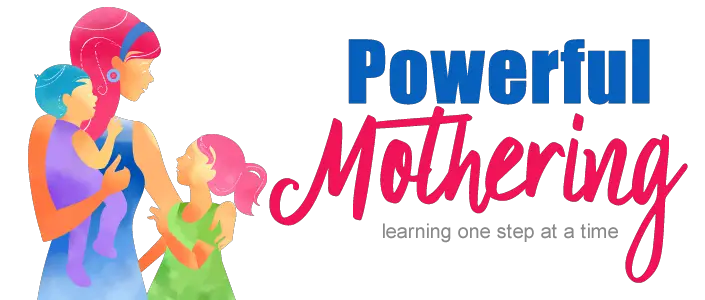This post may contain affiliate links. If you use these links to buy something we earn a commission at no extra cost to you. Powerful Mothering is supported by its audience, thankyou!
Teaching letter sounds to children can sound like a scary process, but I promise it doesn’t have to be. Below you’ll find 7 tips for teaching kids about the sounds letters make, as well as a few activities to try with the children.

Tips for Teaching Letter Sounds
Here are some of my best tips for teaching letter sounds. The list is, by no means, exhaustive! Feel free to share some of your own best tips in the comments below. I’d love to hear what works best for you.
Start with the Child’s Name
When you’re staring at the entire alphabet and trying to decide where to start, you might feel a little overwhelmed. So let me allay your worries a bit here.
Starting with your child’s name will narrow down where you should begin AND it will be more meaningful for your child. I am all about meaningful early literacy, as it makes the learning “stick” more with children.
Suggested: Name Tracing Worksheet
Once your child has a grip on the sounds each letter in her name makes, move onto other important words. Family members’ names, the names of favorite animals, etc.
Teach the Correct Letter Sounds
This tip is so important, especially as children move on to learning to read. Some adults add the “-uh” sound to the end of letter sounds inappropriately. For example, the letter D makes the /d/ sound, as in the word dog. Some adults mistakenly say “D says duh” and accentuate the “-uh” at the end.
It’s important that children are learning the appropriate letter sounds right off the bat, or they will end up confused when they’re beginning to decode words.
Teach Similar Sounds at Different Times
When you’re first starting out, try to separate letters that make similar sounds. For example, B and P make similar sounds, as do T and V. So work on learning those letter sounds at different times.
As children have a better grasp of each letter’s sound, the possibility of confusion will lessen.

Teach Multiple Letters at a Time
I’m not a big fan of the traditional “letter of the week” method because it tends to hyper-focus on just one letter at a time. While you don’t want to inundate your child with too much at once, learning about multiple letters each week is the way to go. In fact, I highly suggest that the entire alphabet be available all of the time, even if you’re just focused on certain letters any particular day.
Reading and writing encompass the entire alphabet, so it’s important for children to be exposed to all of the letters and see how letters work together in literacy.
Play Games and Have Fun
Children like playing and having fun, as they should. And it’s important for kids to understand that learning can be fun, so incorporate play and games into your letter sound instruction.
Some games might include a basic game of bingo where the focus is on the sounds each letter makes. Most kids love playing bingo, so why not incorporate those letter sounds?
Picture sorts are another fun and easy game to play when learning about sounds. Place a few letters out on a table, and then have the children sort pictures underneath the appropriate letter based on their initial sounds.
These letter sound games don’t need to come with materials, either. For example, you could play an I-Spy game while driving in the car on the way to errands. “I spy something that starts with /l/, the sound L makes.”
Keep Reading
Children of all ages, even those who are already reading themselves, benefit from cuddling up and listening to their parents read aloud. While you’re reading to your child, encourage him to follow along in the text when possible.
You can take a moment here and there when reading to point out letters and the sounds they make. “Look here. This word starts with an M just like your name. M says /m/ like Mary!” In all likelihood, eventually your child will start pointing out things like this, making connections between what they’re learning and books.
Make the Connection with Writing
Reading and writing go hand-in-hand. Show the children that knowing the letters and their sounds has a big impact on how they can communicate. One of the best ways to do this is when the children draw pictures.
After they’ve excitedly shown you one of their masterpieces, ask the child, “Do you want me to write down your story?” Have the child dictate a short sentence or two, and then write their story down word for word. Make a point of explaining out what you’re doing, “I know I need to write the letter M when I’m writing ‘mom’ because M says /m/.”

Some Activities for Teaching Letter Sounds
Here are some ideas to inspire you:
Sort magnetic letters a variety of ways, and be sure to discuss the sounds each letter makes as the kids sort.
Use these printable short vowel pictures to explore the sounds vowels make.
Set up a science activity involving icy, fizzing letters. Have the kids say the sound of each fizzing letter. Challenge them to come up with words that start with that letter sound.
Put together an alphabet sensory bin for the children. As they find each letter, have the kids say the sound out loud. Similar can be done with this Sensory Bin full of letters.
What are some of your favorite activities for teaching letter sounds to children?
Mary Catherine is a mother, an early childhood educator, and the force behind Fun-A-Day. She’s passionate about keeping early learning fun, meaningful, and developmentally appropriate.









Leave a Reply